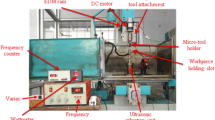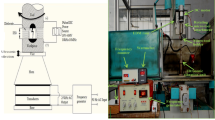Abstract
This experimental examination exhibit a novel Hybrid Wire electrical discharge machining (H-WEDM) process of ultrasonic vibration combined with traditional Wire-EDM. The metal cutting for form tool and extrusion die with WEDM is liked to give better surface morphology. The effect of residual stresses has been dissected for H-WEDMed machined surface alongside the surface roughness and erosion rate to enhance surface integrity and longer service life of High Carbon High Chromium D2 tool steel. The process parameters chose for this investigation are type of vibration continuous/discontinues, amplitude of vibration, workpiece dimension, duty cycle, peek current and wire feed rate with objective to optimize the residual stresses and erosion rate. Portable X-ray Residual Stress Analyzer, a non-destructive X-ray analyzer is used to measure the residual stress efficiently by detecting the full Debye ring data from a single incident X-ray angle and Non goniometer stage influence on the measurements. An endeavor was made to compare the residual stresses for continuous/discontinues vibration and without vibration. The impacts of amplitude of vibration, peak current, duty cycle and wire feed rate variations on erosion rate was study using Taguchi method. From experimental study, it was observed that discontinuous vibration enhances the erosion rate and diminishes the resultant stresses. High Peak current and duty cycle altogether deteriorate the surface texture, which creates high tensile residual stresses because of debris and micro cracks. The optimum value of residual stresses 86.53 MPa and material erosion rate 6.45 mm/min was achieved using H-WEDM.













Similar content being viewed by others
References
Antar, M.T., Soo, S.L., Aspinwall, D.K., Sage, C., Cuttell, M., Perez, R., et al.: Fatigue response of Udimet 720 following minimum damage wire electrical discharge machining. Mater. Des. 42, 295–300 (2012)
Ashyralyev, A.: Nonlocal boundary-value problems for elliptic equations: well-posedness in bochner spaces. AIP Conf. Proc. 1309, 66–84 (2010)
Capello, E.: Residual stresses in turning: part I: influence of process parameters. J. Mater. Process. Technol. 160(2), 221–228 (2004)
Ekmekci, B., Elkoca, O., Tekkaya, A.E., Erden, A.: Residual stress state and hardness depth in electrical discharge machining: de-ionizaed water as dielectric liquid. Mach. Sci. Technol. 9, 39–61 (2007)
Fischer, X., Coutellier, D.: Research in Interactive Design. Springer, Paris (2007)
Ghanem, F., Fredj, N.B., Sidhom, H., Braham, C.: Effects of finishing processes on the fatigue life improvements of electro machined surfaces of tool steel. Int. J. Adv. Manuf. Technol. 52, 583–595 (2011)
Guo, Z.N., Lee, T.C., Yue, T.M., Lau, W.S.: A study of ultrasonic-aided wire electrical discharge machining. J. Mater. Process. Technol. 63, 823–828 (1997)
Guo, Z.N., Lee, T.C., Yue, T.M., Lau, W.S.: Study on the machining mechanism of WEDM with ultrasonic vibration of the wire. J. Mater. Process. Technol. 69, 212–221 (1997)
Guu, Y.H., Chou, Y.C., Chiou, S.-T.: Study of the effect of machining parameters on the machining characteristics in electrical discharge machining of Fe–Mn–Al alloy. Mater. Manuf. Process. 20(6), 905–916 (2004)
Han, G., Soo, S.L., Aspinwall, D.K., Bhaduri, D.: Research on the ultrasonic assisted WEDM of Ti–6Al–4V. Adv. Mater. Res. 797, 315–319 (2013)
Ho, K.H., Newman, S.T.: State of the art electrical discharge machining (EDM). Int. J. Mach. Tools Manf. 43, 1287–1300 (2003)
Kansal, H.K., Singh, S., Kumar, P.: Parametric optimization of powder mixed electrical ischarge machining by response surface methodology. J. Mater. Process. Technol. 169(3), 427–436 (2005)
Khosrozadeh, B., Shabgard, M.: Effects of hybrid electrical discharge machining processes on surface integrity and residual stresses of Ti–6Al–4V titanium alloy. Int. J. Adv. Manuf. Technol. 93, 1999–2011 (2017)
Klinka, A., Guo, Y.B., Klockea, F.: Surface integrity evolution of powder metallurgical tool steel by main cut and finishing trim cuts in wire-EDM. Procedia Eng. 19, 178–183 (2011)
Kremer, D., Lebrun, J.L., Hosari, B., Moisan, A.: Effects of ultrasonic vibrations on the performances in EDM. Ann. ClRP 38(1), 199–202 (1989)
Kumar, s, Grover, S., Walia, R.S.: Optimisation strategies in ultrasonic vibration assistedelectrical discharge machining: a review. Int. J. Precis. Technol. 7(1), 51–84 (2017)
Liu, J.F., Guo, Y.B.: Residual stress modeling in electric discharge machining (EDM) by incorporating massive random discharges. Procedia CIRP 45, 299–302 (2016)
Peterson, N., Kobayashi, Y., Traeger, B., Sanders, P.: Assessment and validation of Cos? Method for residual stress measurement. In: 13th International Conference on Shot Peening, pp. 80–86 (2017)
Ramakrishnana, R., Karunamoorthy, L.: Modeling and multi-response optimization of Inconel 718 on machining of CNC WEDM process. J. Mater. Process. Technol. 207, 343–349 (2008)
Rao, P.S., Ramji, K., Satyanarayana, B.: Effect of wire EDM conditions on generation of residual stresses in machining of aluminum 2014 T6 alloy. Alex. Eng. J. 55, 1077–1085 (2016)
Ross, P.J.: Taguchi Techniques for Quality Engineering. McGraw-Hills Book Company, New York (1988)
Roy, R.K.: A Primer on Taguchi Method. Van Nostrand Reinhold, New York (1990)
Sasaki, T., Miyazaki, T., Ito, H., Furukawa, T., Mihara, T.: X-ray residual stress analysis of nickel base alloys. Adv. Mater. Res. 922, 274–279 (2014)
Shabgard, M.R., Alenabi, H.: Ultrasonic assisted electrical discharge machining of Ti–6Al–4V alloy. Mater. Manuf. Process. 30, 991–1000 (2015)
Sidhom, H., Ghanem, F., Amadou, T., Gonzalez, G., Braham, C.: Effect of electro discharge machining (EDM) on the AISI316L SS white layer micro structureand corrosion resistance. Int. J. Adv. Manuf. Technol. 65, 141–153 (2013)
Singh, J., Walia, R.S., Satsangi, P.S., Singh, V.P.: FEM modeling of ultrasonic vibration assisted workpiece in EDM process. Int. J. Mech. Syst. Eng. 1(1), 8–16 (2012)
Singh, J., Walia, R.S., Satsangi, P.S., Singh, V.P.: Hybrid electric discharge machining process with continuous and discontinuous ultrasonic vibrations on workpiece. Int. J. Mech. Syst. Eng. 2(1), 22–33 (2012)
Soo, S.L., Antar, M.T., Aspinwall, D.K., Sage, C., Cuttell, M., Perez, R., et al.: The effect of wire electrical discharge machining on the fatigue life of Ti–6Al–2Sn–4Zr–6Mo aerospace alloy. Procedia CIRP 6, 215–219 (2013)
Srivastava, V., Pandey, P.M.: Effect of process parameters on the performance of EDM process with ultrasonic assisted cryogenically cooled electrode. J. Manuf. Process. 14, 393–402 (2012)
Walia, R.S., Shan, H.S., Kumar, P.: Improving EDM process efficiency by ultrasonic vibrations. J. Pure Appl. Ultrason. 26(2/3), 84–89 (2004)
Acknowledgements
The authors acknowledge Department Mechanical Engineering, YMCA UST Faridabad, India, for providing the necessary wire electric discharge machine tool with additional set-up for experimentation. The authors are also thankful to Department of Mechanical and Production, DTU Delhi, India, for providing stress analyzer facility.
Author information
Authors and Affiliations
Corresponding author
Rights and permissions
About this article
Cite this article
Kumar, S., Grover, S. & Walia, R.S. Effect of hybrid wire EDM conditions on generation of residual stresses in machining of HCHCr D2 tool steel under ultrasonic vibration. Int J Interact Des Manuf 12, 1119–1137 (2018). https://doi.org/10.1007/s12008-018-0474-8
Received:
Accepted:
Published:
Issue Date:
DOI: https://doi.org/10.1007/s12008-018-0474-8




